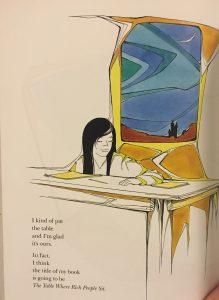
Author: Jacqueline Woodson
Illustrator: E.B. Lewis
Publisher and Year: Nancy Paulson Books 2012
Number of pages: 28
Genre: Fiction
Analysis
Each Kindness is a Coretta Scott King Award winner and tells the story of an elementary school classroom that gets a new student named Maya. Maya often dresses in worn out clothes and is ignored and made fun of by the other children, especially the narrator Chloe. Chloe is one of Maya’s biggest bullies. Maya does not make friends with the class and eventually her family moves. After Maya’s departure, the teacher, Ms. Albert, speaks to the class about kindness and changes Chloe’s mind about being kind to others.
This story is told from the perspective of Maya’s classmate who she sits next to and attempts to interact with. Chloe is consistently rude, ignores Maya, and makes fun of her with her friends. In the end, after Ms. Albert conducts the lesson on kindness, Chloe reflects on her sadness that she mistreated Maya and would not have a chance to make it up to her. This book delves into the importance of economic differences and bullying in schools.

While this book is a good tool to show how kindness can be spread, there are some flaws in the presentation of a classroom. While Maya struggles consistently for several months with the rest of the class, her teacher does not step in and attempt to make the rest of the class stop bullying Maya, until she is gone. At that point it makes a change in Chloe’s future action, but does not change her previous actions to Maya. This enforces the idea that in a classroom the teacher wouldn’t step in until it is too late to benefit the person being picked on. While the teacher’s lesson at the end of the book about ripples and chain reactions in relation to kindness is proven to be a successful lesson with the way it impacts Chloe, there is no impact on Maya. This is a problem because it reinforces the idea that the students can get away with this bullying behavior and only have repercussions later on.
One of the positive things about the book is that in the classroom the students are illustrated as all different races. Overall, this book would be a good tool to use in a classroom to teach about kindness and deal with bullying problems, but classroom ideologies should not be modeled after the teacher in the text and one should be more vigilant in looking out for these bullying behaviors.

















![2016-05-13_14.07.28[1]](https://blogs.iwu.edu/lrbmt2016/files/2016/05/2016-05-13_14.07.281-300x284.jpg)
![2016-05-13_14.08.39[1]](https://blogs.iwu.edu/lrbmt2016/files/2016/05/2016-05-13_14.08.391-300x149.jpg)
![2016-05-10_00.46.11[1]](https://blogs.iwu.edu/lrbmt2016/files/2016/05/2016-05-10_00.46.111-254x300.jpg)
![2016-05-10_00.44.45[1]](https://blogs.iwu.edu/lrbmt2016/files/2016/05/2016-05-10_00.44.451-300x188.jpg)
![2016-05-10_00.48.04[1]](https://blogs.iwu.edu/lrbmt2016/files/2016/05/2016-05-10_00.48.041-300x266.jpg)
![2016-05-10_00.39.24[1]](https://blogs.iwu.edu/lrbmt2016/files/2016/05/2016-05-10_00.39.241-300x143.jpg)